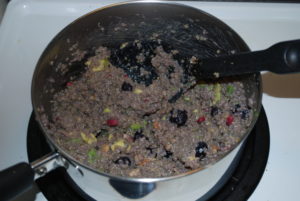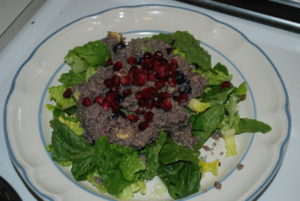What do imaginary goods, virtual cats and superstition have to do with each other? – Economics. ‘Imaginary goods’ is a term used by an Austrian economic theorist from the 1800’s, Carl Menger, to describe goods that might be sold but which did not meet all the criteria of a ‘goods‘ – a thing of value which could be sold or purchased. Imaginary goods could also be sold but they did not meet all of his criteria for ‘goods‘ because their value was more transient – in the imagination of the buyer and/or seller rather than clearly apparent to any normal consumer of goods. (Principles of Economics, by Carl Menger, a translation in English)
As I’ve been working on devising ways to make pomegranate peel edible I’ve been thinking about the idea of a market or demand for a good versus the actual value of the good. You can’t sell something of value if no one considers it valuable even if it fits the criteria of being ‘goods‘ – fulfilling human needs; while it recently was brought to my attention, a refresher course having grown up in era of ‘Pet Rocks,” that some people will pay for anything if it is popular – if other people are bidding on the item too. I was astonished as a child that anyone would pay real money for a rock in a box just because it was called a ‘Pet Rock‘ – just go outside, find a rock, stick it in a box – there you go, your very own ‘pet rock’ captured from its wilderness and tamed for your own enjoyment. The current trend that was brought to my attention is less solid but requires an imagination – virtual cats, bred to have unique characteristics, the bidding is based on the uniqueness of the characteristics (investopedia.com) – my thought, too much time or too much money, and too little space for a real pet cat.
People need love and affection as it promotes oxytocin and dopamine which are hormones that promote positive feelings.
For those with limited room in their lives for an expensive virtual cat, consider going outside and looking for a wild rock to tame instead.
Bringing this back around to the New Year’s Day topic of good luck black-eyed peas and the following day’s topic of superstition – Carl Menger includes in his examples of imaginary goods items that might be considered good luck charms and also medications that aren’t effective.
Pomegranate peel might be effective but until there is proof that it is effective there might not be a market of consumers willing to pay for it let alone even try it. So Master Chef Challenge – Pomegranate Peel -> make it appetizing and if people also feel good after eating it then they will return for seconds -> thus creating a market that hadn’t previously been known.
Carl Menger’s four criteria for what makes something a consumer ‘good’:
“If a thing is to become a good, or in other words, if it is to
acquire goods-character, all four of the following prerequisites
must be simultaneously present:
- A human need.
- Such properties as render the thing capable of being brought
into a causal connection with the satisfaction of this need. - Human knowledge of this causal connection.
- Command of the thing sufficient to direct it to the satisfaction
of the need.” page 52 (Principles of Economics, by Carl Menger, a translation in English)
According to his theory something can lose its value as a consumer good if it stops fulfilling any one of those four criteria, to paraphrase – if we 1: stop needing it because the problem it solved no longer exists, 2: the thing no longer works to solve the original problem 3: we forget that the thing is useful for fulfilling the need, 4: the thing is no longer something humans have access to (the WiFi goes out and the virtual cat breeding stops functioning) :
“Hence a thing loses its goods-character: (1) if, owing to a
change in human needs, the particular needs disappear that the thing is capable of satisfying, (2) whenever the capacity of the
thing to be placed in a causal connection with the satisfaction of
human needs is lost as the result of a change in its own properties,
(3) if knowledge of the causal connection between the thing and
the satisfaction of human needs disappears, or (4) if men lose
command of it so completely that they can no longer apply it
directly to the satisfaction of their needs and have no means of
reestablishing their power to do so.” -pages 52-53 (Principles of Economics, by Carl Menger, a translation in English)
So for those who may have forgotten (reason #3), – caring for living people or pets can help one’s own health through increased oxytocin, dopamine and reduced oxidative stress. If owning a real pet is not possible due to housing issues visiting a local Humane Society type agency and volunteering to help care for the shelter animals is generally possible and appreciated. If money isn’t a problem hiring a human for a service that involves touch such as a manicure is helping others by providing money for jobs and providing oxidative stress reducing touch from the hands-on service. If owning a real pet or hiring human hands-on service isn’t possible than oxytocin, dopamine and possibly even reduction in oxidative stress may be provided by a caring relationship with a houseplant that cleans the air of toxins (ferns and other types), or by enjoying looking at art objects that have to do with nature or possible the touch of a smooth natural object such as a rock or crystal or wooden object.
While my search of oxidative stress and art didn’t turn up the link I was looking for it did find a review of research on male infertility, oxidative stress, antioxidants (vitamin E, C and CoQ10) and ART, assisted reproductive techniques, while it doesn’t mention iodine it’s worth saving for reference and smoking is mentioned as risk: http://ccf.org/reproductiveresearchcenter/docs/agradoc261.pdf
Smoking increases intake of formaldehyde as well as other toxins. There are also other common sources of formaldehyde in modern living environments. Tips for reducing risk of formaldehyde exposure and links for the houseplants that help detoxify indoor air from formaldehyde and other common volatile chemicals are included in an older post, Formaldehyde (volatile – chemicals that might be easily released from plastics or carpets into the air – ie “new car smell”).
The topic on nature and art and oxidative stress is discussed with links in the section Art – Food for the Eyes on another website, effectivecare.info, 10. food Helps Too.
Returning to the Master Chef Challenge – Pomegranate Peel, – it is helping my mood and health more consistently than the 1/2 cup of pomegranate seeds did but it is quite acidic. I’ve taken to using a couple spoonfuls in my bean soup instead of the lime juice or apple cider vinegar that I had been adding as a digestive aid. I’ve also tried it on salads in place of lime juice.
As a beverage I occasionally have the original blend of approximately 3 ounces of the pomegranate extract/soup stock with about 3 ounces of water and 1 ounce of cherry juice with four pinches of Baking Soda (sodium bicarbonate) to make it less acidic. Sugar is inflammatory in itself so I’v stopped using much of it. After the review of the blueberry/rhubarb jam recipe I bought some blueberries and will try a combination of the pomegranate extract with the less acidic fruit. Cherry juice is also acidic. Blueberry juice concentrate is available in specialty stores but I wasn’t at one. The Baking Soda may be too much sodium or something in the pomegranate extract or the level of acidity it adds to the diet may have a diuretic effect like coffee – so like many things in life – it’s not perfect. But being sick isn’t either.
When you start thinking about food as fuel and as your body’s natural medicine cabinet then taste is something that can be acquired and adapted to suit the needs of health – but first the mind has to overpower the habit of “I always eat what my family ate, or what I got used to at college, or whatever my friends are eating.” Social settings and food are very strongly linked and it can be viewed as rude to refuse an offer of food that is being offered – sometimes life isn’t perfect either.
Good luck and best wishes all you Master Chefs out in virtual reader land – I know you can take on whatever culinary challenges you choose.
If at the beginning of 2017 someone predicted that I would successfully be using pomegranate peel, baker’s cocoa, cardamom, and leafy green herbs and vegetables instead of medical marijuana for my autoimmune health condition I might have thought they were imagining things – but Carl Menger was right we have to know the causal connection between a good and a problem it might solve before we go to the effort to purchase, prepare, and use the good for solving that problem/need (health care improvement in my case). pages 51-58, (Principles of Economics, by Carl Menger, a translation in English).
A tastes better than it looks salad – Blueberry Pomegranate Avocado Quinoa Salad.
Bring two and a half cups of water to a boil and add one cup quinoa (or amaranth or cracked wheat for a more traditional tabouli like salad). Cook for twenty minutes at a simmer. Stir occasionally to keep it from sticking to the saucepan. Once the water is fully absorbed remove the pan from the heat and add about (all of the following ingredients are estimates except for the avocado- this is a first try) one tablespoon coconut oil and stir into the hot cooked cereal. Add about one cup of frozen or fresh blueberries, 1/2 cup frozen or fresh pomegranate seeds, 1/4 cup pomegranate peel extract, one chopped ripe avocado, one tablespoon dried tarragon and one tablespoon dried basil (or more if fresh is available), and 1/4 cup chopped walnuts. Stir the mixture thoroughly. The cereal will turn purplish color from the blueberries. Serve a cup or so of the mixture over a plate of chopped salad greens and top with a pretty 1/8th cup of fresh or frozen pomegranate seeds.
I always add salt to taste at the table. We taste only the salt on the surface of food, not what has been cooked into a food or stirred into a mixture as much.
The flavors and textures work well together, sweet and tanginess from the fruit, creaminess from the avocado, quinoa and coconut oil. Tarragon adds flavor, the basil is milder and wasn’t noticeable in the amount I added here. Tarragon has a slightly minty flavor. The walnut is a stronger flavor and the crunch and flavor balance with the flavor of the blueberries and crunch of the pomegranate seeds. This was a success flavor and texture-wise no matter what it looks like and it would be nutritionally balanced with protein, essential fats and carbohydrates and plenty of fiber and trace nutrients and antioxidants. Walnuts and blueberries have both been found effective for cardiovascular health and male health issues.


Disclaimer: Opinions are my own and the information is provided for educational purposes within the guidelines of fair use. While I am a Registered Dietitian this information is not intended to provide individual health guidance. Please see a health professional for individual health care purposes.
